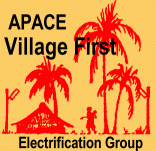|
Back to project list
Agaun
Back to project list
A micro hydroelectricity power system now fully operated and maintained by the remote Agaun community, which sells excess power to a Government station nearby.
The Daga-speaking people of Milne Bay Province in PNG live in a remote region directly east of Moresby in the easterly end of the Owen Stanley Ranges. There is no road access, although some Daga people have occasionally walked over several days by mountainous track to the coast when there has been an exceptional need, such as a funeral or medical emergency.
The beauty of the valley belies the reality of a harsh life of poverty, lack of basic opportunities and limited information upon which to develop opportunities.
The several hundred villagers in the area have little opportunity for cash generation through the more usual products such as fish or vegetables or copra production, since transport makes the economics quite unsustainable. Fish are in fact not available in any quantity, and protein deficiencies are commonplace.
APACE was asked in the late 1980's to help develop the use of the Jura river flowing past Agaun village, given the local belief that a small hydroelectric system would achieve several basic objectives:
1. The hydroelectric facility would provide lighting and basic services for village people, such as the powering of a radio set in an area where the cost of batteries was generally beyond reach.
2. The hydro system could provide an outlet for youth talents and some small income from employment in maintenance.
3. The system could potentially provide small village industries, centred around agricultural processing, that could benefit directly all the hundreds of residents struggling for a sustainable lifestyle within the Agaun region.
Such a dream may perhaps have seemed far-fetched to a project manager accustomed to designing on financial and economic models, without consideration of the 'externalities' of the particular characteristics of people within the Agaun village cooperative. It has taken a decade of local hard work from Agaun people, from volunteers from APACE (Paul, Donnella, Ed, Alex and others), APACE members and donors, support from the Canada Fund, the Australian NGO cooperation scheme, the Milne Bay Province and Chris of Masurina Ltd at Alotau.
The results are now in place. Agaun people see the Jura hydro as a continuing monument to village determination and self-help, to cooperation between the Australian APACE community and a PNG community in need of opprtunity, as well as a practical and sustainable technology transfer.
At this time, Andrew and John of Agaun village are employed in maintenance of the APACE-designed micro hydroelectric system that generates power for household lights and limited electric power. The village enjoys a tariff from the Agaun station provincial employees [at times when the Province has funds to pay their employees] since the village-owned hydro exports power to the Government station.
Clement, also from Agaun village, transmits weather reports each morning and evening using a hydro-charged battery radio set, supporting his family from the small National meteorological service budget [when it is solvent]. The hydro also supplied electricity to heating coils inside a clay-insulated oven that dries local cardamon seeds for export. Cardamon trees are beginning to multiply in the valley, and there is some hope for the future.
Agaun village's hydroelectric system consists of a Tamar turgo wheel turbine assembled with a Stamford self-excited synchronous alternator. The power output is 28 kWatt. The power from this assembly is monitored by an APACE/UTS designed fail-safe frequency detector and gravity-operated flapgate, that ensures power is cut off when overspeed or underspeed conditions are sensed. The Agaun community, and particularly Clement and Andrew, keep regular maintenance and cleaning checks of the flapgate and forebay area, since the basic long-term reliability of a small village hydro system lies in ensuring the water entering the turbine is clean.
Water feeds to the forebay via a locally made headrace, constructed over a 300 metre length. The headrace transmits a small percentage of the Jura River over an almost level channel lined with local rocks and pebbles, sometimes through a tunnel of rock and masonry constructed to protect the headrace from rubble that occasionally slides down the steep mountain slopes in times of earth tremors and heavy storms.
The Jura River flows abundantly, and a small portion is diverted into the headrace via a rock barrier, a simple line of loose rocks about 15cm high. The original locally-made barrier was more substantial, but was washed away in the flood times. The current solution is based on maintainability and replaceability rather than longevity. As in all APACE micro hydroelectric systems, there is no storage of water, and hence no prospect of environmental changes that accompany large hydro operation.
Power from the turbine-generator unit is fed over the grassland plain and up a steep slope to the village, via 16 sq. mm aluminium cables operating at 3300 Volts. The power is stepped down to 240 Volt AC at a transformer station mounted high above Father Clement Bateman's workshop on the perimeter of the village. Here a switchboard and control room houses an APACE/UTS electronic load governor that keeps voltage and frequency levels stable within the distribution system. In a nearby room, the locally-fabricated cardamon ovens are being fed through APACE heater/blower fans to provide a high grade exportable spice seed. (Note: As of April 2004 the ovens were not functioning due to lack of marketing opportunities for the seed).
Back to project list
|





